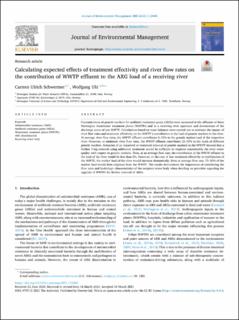| dc.contributor.author | Schwermer, Carsten Ulrich | |
| dc.contributor.author | Uhl, Wolfgang | |
| dc.date.accessioned | 2021-07-14T08:51:50Z | |
| dc.date.available | 2021-07-14T08:51:50Z | |
| dc.date.created | 2021-04-08T11:38:29Z | |
| dc.date.issued | 2021 | |
| dc.identifier.citation | Journal of Environmental Management. 2021, 288, 112445. | en_US |
| dc.identifier.issn | 0301-4797 | |
| dc.identifier.uri | https://hdl.handle.net/11250/2764348 | |
| dc.description.abstract | Concentrations of genetic markers for antibiotic resistance genes (ARGs) were measured in the effluents of three Norwegian wastewater treatment plants (WWTPs) and in a receiving river upstream and downstream of the discharge point of one WWTP. Calculations based on mass balances were carried out to evaluate the impact of river flow rates and treatment effectivity on the WWTP's contribution to the load of genetic markers in the river. At average river flow rates, the WWTP effluent contributes 5–15% to the genetic marker load of the respective river. However, at minimum river flow rates, the WWTP effluent contributes 22–55% to the loads of different genetic markers. Scenarios of an improved or worsened removal of genetic markers in the WWTP showed that a further 1-log removal using additional treatment would be sufficient to improve considerably the river water quality with respect to genetic markers. Then, at an average flow rate, the contribution of the WWTP effluent to the load of the river would be less than 2%. However, in the case of low treatment effectivity or malfunction of the WWTP, the marker load of the river would increase dramatically. Even at average flow rate, 75–92% of the marker load would then originate from the WWTP. The results demonstrate the importance of considering the flow rates and hydrologic characteristics of the recipient water body when deciding on priorities regarding the upgrade of WWTPs for further removal of ARGs. | en_US |
| dc.language.iso | eng | en_US |
| dc.publisher | Elsevier | en_US |
| dc.rights | Navngivelse 4.0 Internasjonal | * |
| dc.rights.uri | http://creativecommons.org/licenses/by/4.0/deed.no | * |
| dc.title | Calculating expected effects of treatment effectivity and river flow rates on the contribution of WWTP effluent to the ARG load of a receiving river | en_US |
| dc.type | Peer reviewed | en_US |
| dc.type | Journal article | en_US |
| dc.description.version | publishedVersion | en_US |
| dc.rights.holder | © 2021 The Author(s). | en_US |
| dc.source.pagenumber | 14 | en_US |
| dc.source.volume | 288 | en_US |
| dc.source.journal | Journal of Environmental Management | en_US |
| dc.identifier.doi | 10.1016/j.jenvman.2021.112445 | |
| dc.identifier.cristin | 1902929 | |
| dc.source.articlenumber | 112445 | en_US |
| cristin.ispublished | true | |
| cristin.fulltext | original | |
| cristin.qualitycode | 1 | |

